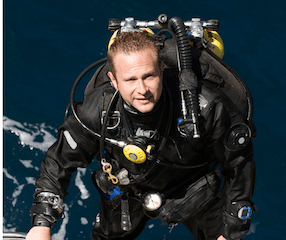Last Updated on November 16, 2021 by Dan
Dry suit diving is a type of scuba diving that involves using dry suits for insulation. A drysuit diver will wear neoprene boots, gloves, hood and dry mask to protect the body against water. It’s great for people doing cold water diving, or ice diving and ensuring you keep warm.
The dry suit diver wears gloves so they can retrieve objects from under the water such as ribbons, flags or buoys or to inspect equipment. Drysuits must be tightly sealed in order for divers to stay dry. There are three ways dry suits keep users dry: waterproof fabric, bladder buoyancy and mechanical zippers/seals.
Bladders, also known as an “active dry” system like the ones used in semi submerged scuba diving allow users to remain dry while maintaining optimal thermal comfort and safety.
The drysuit bladders are attached to drysuit material so they can be easily filled or emptied. The drysuit is pressurized with air, supplied by the diver’s drysuit inflation device, which helps increase comfort and warmth while holding in body heat trapped by the drysuit.
Waterproof fabric dry suits use a neoprene lined nylon (or polyester) shell that is completely waterproof when zipped shut. They were designed for surfers who wanted to stay warm in cold waters and did not want water inside their wetsuit ruining it.
Advantages of Drysuit Diving
Drysuits with waterproof fabric allow divers more movement than drysuits using a bladder system, but at a lower cost. One disadvantage of this type of drysuit is that the outside will get wet if there is a tear or rip in the drysuit.
The drysuit shell fabric is coated with a membrane that keeps you dry when you enter the water and allows air to escape when submerged. The drysuit’s dry area has zippers for entry and exit because air can only escape from the inside of the suit through these holes, while water cannot seep inside.
Mechanical dry suits use waterproof zippers to close up all parts of the drysuit so no water comes into contact with your skin. This type of drysuit consists of two layers that are attached together by one long zipper which seals off all openings in the drysuit, except for where your head goes.
The inner layer will have an opening for your face, dry gloves and dry boots. Your drysuit will have a dry glove on the dry suit so you can easily adjust devices inside your drysuit or take it off.
Drysuits with mechanical zippers are more flexible than other drysuits, but water is able to get in the neck area of the dry suit if there is a tear or rip in the fabric.
Drysuits must be completely waterproof for use underwater as they keep out water that can lead to drowning, hypothermia and environmental damage (corrosive to coral reefs).
If you don’t want water seeping into your drysuit, make sure all of its zippers are closed securely before entering the water.
Disadvantages of Drysuit Diving
Dry suit diving is not as dry as it sounds, as divers will carry a dry suit inflation device that must be regularly refilled. Divers will also feel bulky and heavy when wearing dry suits. The dry suit may cause the face to itch or sting – some drysuits have linings made of silicone and nylon that are built with anti-abrasion properties.
Where drysuit diving can take place? Drysuit diving is suited for warm waters that temperatures range from 50 to 90° F (10 – 32 °C). Colder climates require additional layers of clothing under the dry suit in order to stay warm.
How to choose a drysuit
When selecting your drysuit try on several different brands/sizes. The drysuit should fit snugly but not too tight (no wrinkles or gaps). Make sure the drysuit is dry inside and out before you purchase it. You need to test the drysuit air inlets and ensure that they are functioning properly.
Drysuits have a sleek design, lack of bulky buoyancy compensator and allow more mobility than dry suits with bladder systems. They also weigh less than dry suits with bladders.
Drysuits can be made from different materials: neoprene rubber, synthetic fabric such as nylon or polyester, silicone rubber or vinyl; each type has its own pros/cons:
High Density Neoprene Rubber- dry suit will keep warm water out while keeping warm water in, dry and flexible.
Synthetic Fabric – dry suit is easy to squeeze into a dry bag, dry and comfortable while still being warm.
Silicone Rubber or Vinyl- drysuit is very tough that can withhold bumps from rocks or other underwater objects, dry but heavy and bulky.
It’s a matter of personal preference and budget which one you choose. Drysuits come in two general types: open front (or diver’s wetsuit) and full-body type (battery operated heated dry suits). Open-front dry suits have a neck seal which forms an air pocket between the seal and skin when you submerge your head; this allows more movement than full bodysuits.
Open front drysuits are best for skin diving activities since you do not need to bend over or undergo much movement when engaging in your drysuit activity. These drysuits are also easier to wear and take off, dry faster after use and dry out completely onshore before the next dive.
Full body dry suits have air bladders that may be battery operated (wet/dry suit) or manually filled with air. Full body dry suits are made of two separate nylon layers joined together by an accordion-like zipper – this type is more flexible than a mechanical drysuit but less watertight than a wet/dry suit as there is no inner dry layer; however, water will not get into your drysuit if you make sure all zippers are closed securely prior to entering the water.
Wet/Dry dry suits are best for cold waters or drysuit activities that require less bending and movement. These drysuits are also ideal for drysuit diving activities where the water is shallow and clear as you can take photos without making contact with the surface of the water (some harnesses come with a camera mount).
Full drysuits (battery operated) have internal heating systems that keep divers warm; however, they restrict your range of motion. The cost of battery-operated dry suits may be an investment in the future – drysuit divers do not have to wear wetsuits when diving in scuba gear since the heat generated from the body will regulate core temperature.
Dry Suits Tips & Hints
Test out your drysuit before you get into the water.
Check dry suit air lines for leaks and dryness inside and out before putting it on; drysuit water inlets are often located at your drysuit’s wrists and ankles – they may drain drysuit air when submerged, so you need to dry your drysuit thoroughly after each dive.
Your helmet will not fog up if all zippers are closed prior to getting into the water and while underwater, drysuits have better thermal efficiency than wetsuits since there is no moist layer – drysuits should be worn over neoprene gloves (they help keep hands warm) as well as a hood or cap to cover head. However, you can wear both layers on top of each other making drysuit a dry and comfortable dry thermal system.
A drysuit will last longer if it is well cared for.
Clean your drysuit after each use, dry completely – gently pulling down the neck seal to remove excess water from inside the drysuit will help.
Drysuits should be stored where they are not exposed to sunlight as UV rays can break down neoprene rubber over time; dry suits can withstand cold temperatures and maybe hung up with big freeze plugs in place of ice bags (drysuits contain less air than wetsuits so freeze plugs won’t make them bulky). Drying all parts of your drysuit out in open air is recommended before putting it back into a storage bag or case as a dry drysuit will dry faster than a wet drysuit.
Dry Suits Specifications:
Look for drysuit gaskets that are sewn and glued together to avoid leaks.
Avoid dry suits with neck seals that blow up too much; this could restrict your range of motion when using a regulator hose, wearing SCBA gear (self-contained breathing apparatus) or simply turning around while inside the drysuit .
Choose neoprene drysuit material that is thicker at seams; thinner materials tend to wear more quickly so it’s best to buy the best quality and most expensive one you can afford. The benefit of buying higher-priced drysuits is in the construction which will be smoother, stronger and last longer.
We hope this article has helped you learn about this alternative form of diving.

